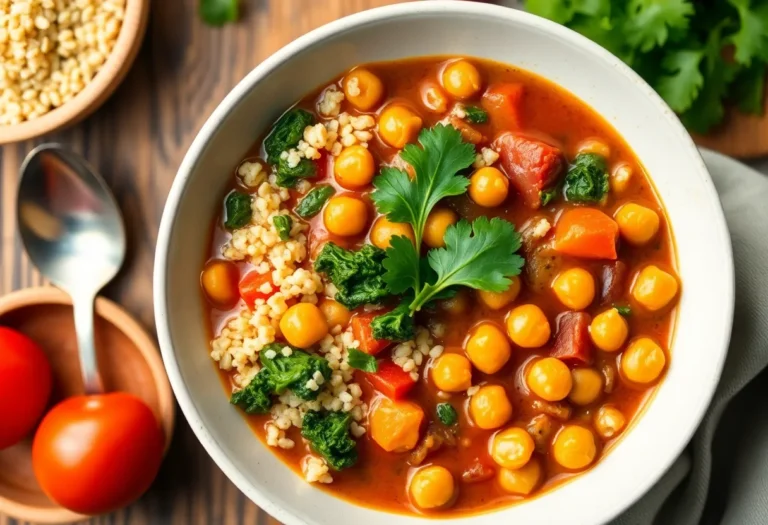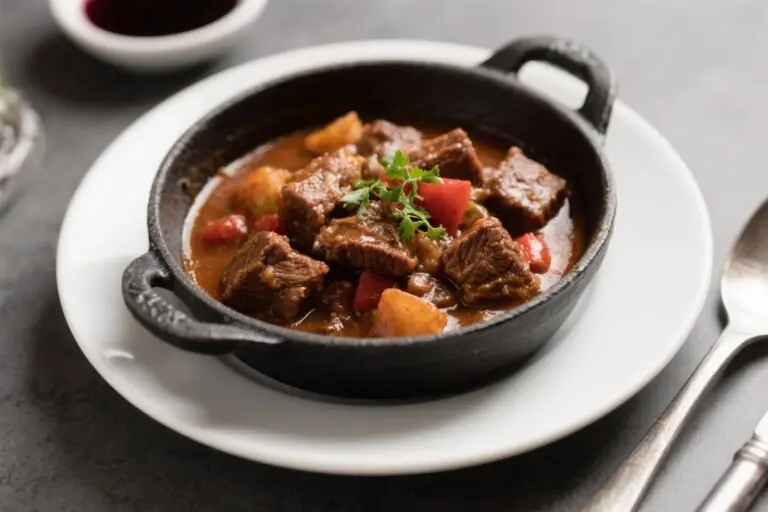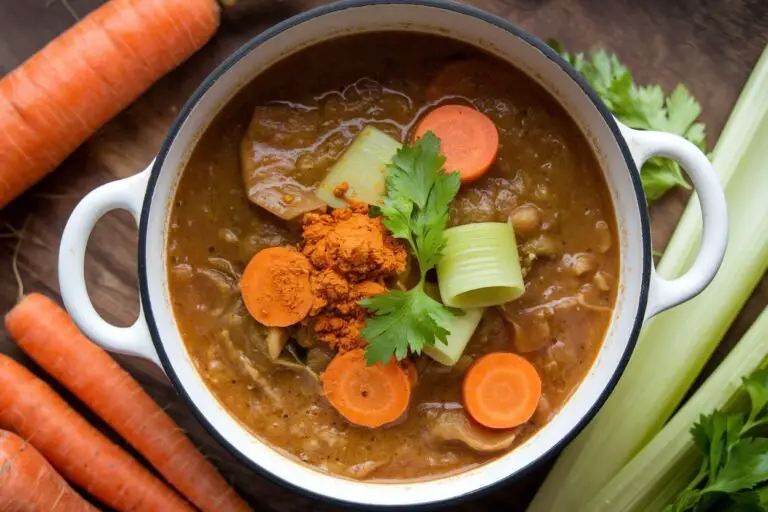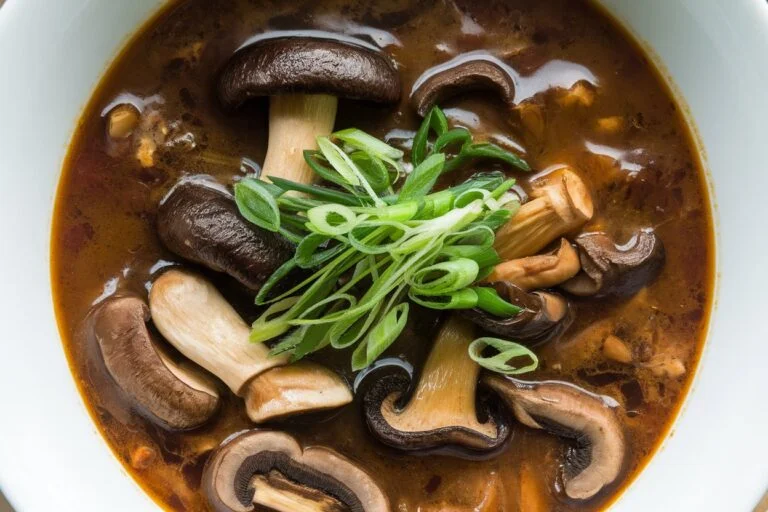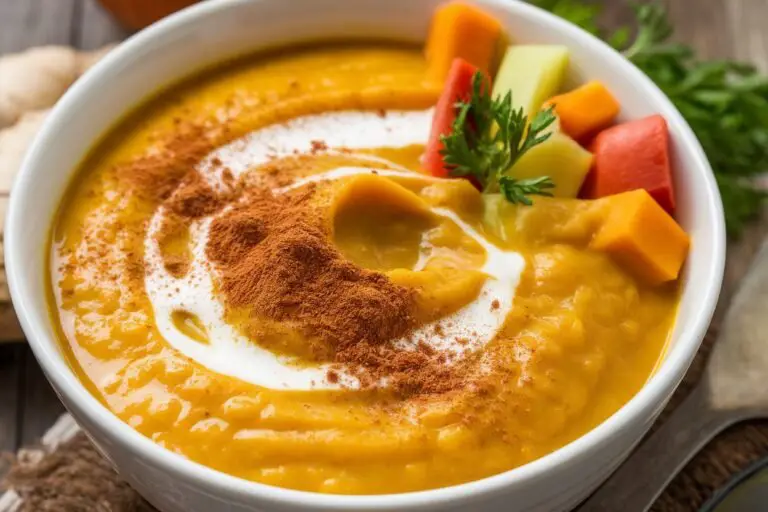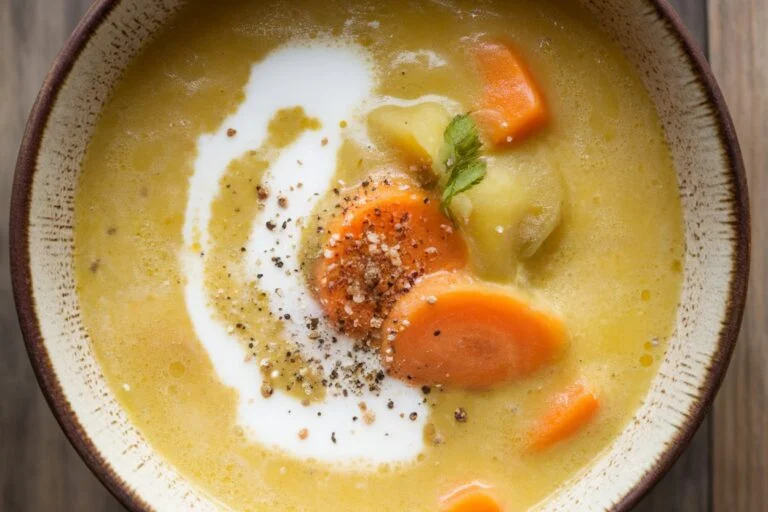Korean Braised Beef Stew (Galbi Jjim) – Rich, Tender, and Comforting
Galbi jjim is the kind of meal that feels like a warm hug. Tender beef short ribs, slow-cooked in a savory-sweet soy sauce with garlic, ginger, and a hint of heat—this dish is all about deep comfort and balance. It’s festive enough for a special occasion yet cozy enough for a weeknight treat.
With the right cut of beef and a few smart steps, you’ll get that fall-off-the-bone tenderness and glossy sauce that clings to every bite. Serve it with steamed rice, and you’re set.
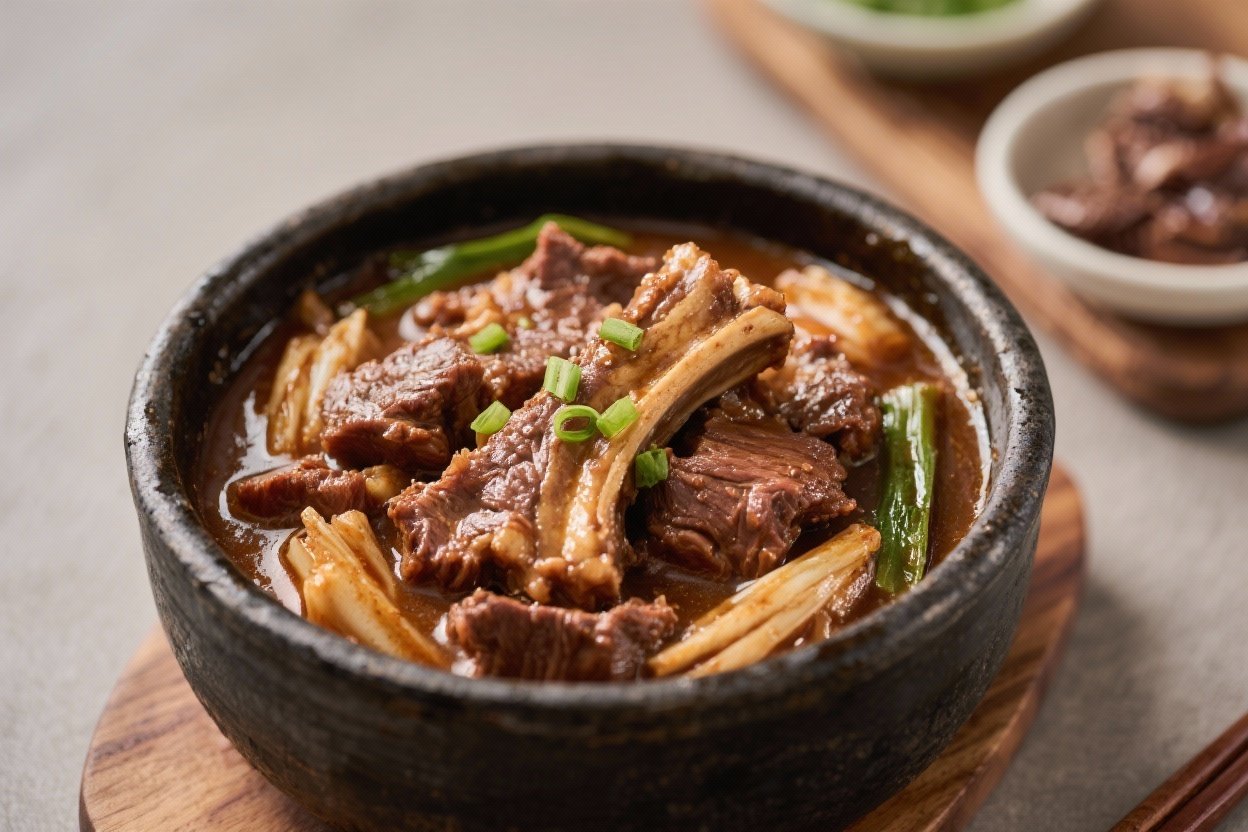
Korean Braised Beef Stew (Galbi Jjim) - Rich, Tender, and Comforting
Ingredients
Method
- Prep the ribs. Rinse the short ribs under cold water. Trim excess surface fat but leave some for flavor.Soak in cold water for 20–30 minutes to draw out blood, changing the water once.
- Blanch. Place ribs in a large pot, cover with cold water, and bring to a boil. Simmer 5–8 minutes until foam rises. Drain and rinse the ribs and pot to remove scum.
- Make the braising sauce. In a bowl, whisk soy sauce, brown sugar, honey, mirin, water, grated pear, minced garlic, minced ginger, sesame oil, gochugaru, and black pepper.
- Start the braise. Return the blanched ribs to the clean pot.Add onion, smashed garlic, sliced ginger, and the braising sauce. Add enough water to barely cover the ribs if needed.
- Simmer low and slow. Bring to a gentle simmer, cover, and cook over low heat for 60–75 minutes. Skim fat as it rises for a cleaner sauce.
- Add hearty vegetables. Stir in carrots, potatoes, daikon, mushrooms, and jujubes (if using).Continue simmering uncovered 25–35 minutes, until the vegetables are tender and the sauce thickens.
- Reduce and finish. If the sauce is still thin, remove the lid and let it bubble for 5–10 more minutes to reduce to a glossy consistency. Add scallions in the last 2–3 minutes.
- Check seasoning. Taste and adjust. Add a splash of water if too salty, a pinch of sugar if too savory, or more black pepper for warmth.
- Serve. Sprinkle with sesame seeds.Serve hot with steamed rice and, if you like, kimchi or simple greens.
Why This Recipe Works
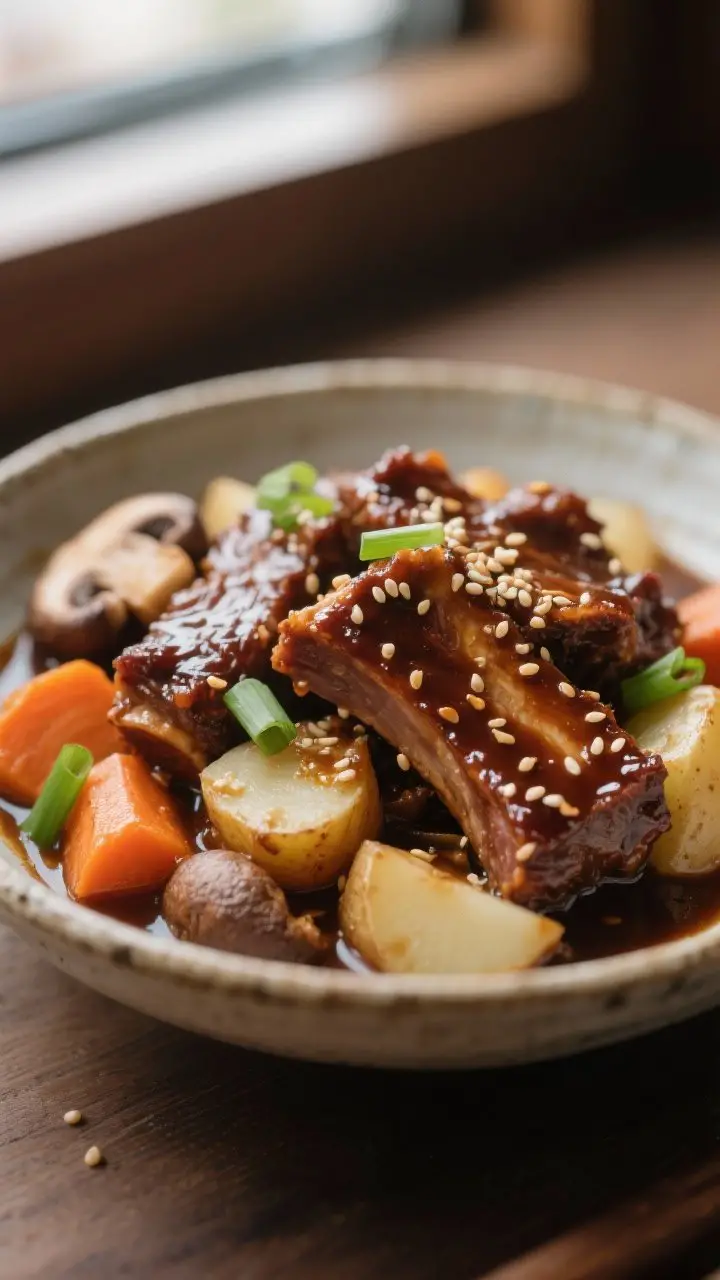
- Blanching the ribs first removes impurities, giving you a clean, clear sauce without bitterness or foam.
- A balanced braising sauce—soy, sugar, mirin, garlic, and ginger—creates savory depth with gentle sweetness and aroma.
- Low and slow cooking breaks down the connective tissue, turning tough short ribs buttery and tender.
- Staggered vegetable timing keeps carrots and potatoes intact rather than mushy.
- Final reduction thickens the sauce naturally so it coats the ribs without cornstarch.
Ingredients
- 3 pounds beef short ribs, English-cut (about 2–3 inches thick)
- 1 medium onion, quartered
- 4–5 cloves garlic, smashed
- 1 thumb-sized piece ginger, sliced
- 2 medium carrots, cut into large chunks
- 2 medium potatoes (Yukon Gold or russet), cut into large chunks
- 1 cup daikon radish, peeled and cut into 1.5-inch pieces (optional but traditional)
- 6–8 dried jujubes (Korean dates), optional for sweetness
- 8–10 shiitake mushrooms, stems removed (fresh or rehydrated dried)
- 2–3 scallions, cut into 2-inch pieces
- 1 tablespoon toasted sesame seeds, for garnish
- Steamed white rice, for serving
Braising Sauce:
📖 Get Access to 50+ Printable Smoothie Recipes Instantly! 🖨️
Boost your health with delicious smoothies! These easy-to-follow printable recipe eBooks are perfect for detoxing, fitness goals, and tasty plant-based living. Available for instant download on Etsy! 🌿✨
- 3/4 cup soy sauce (preferably Korean or light soy, not dark)
- 1/3 cup brown sugar (adjust to taste)
- 2 tablespoons honey (or more brown sugar)
- 1/4 cup mirin (or rice wine)
- 1/2 cup water
- 1 small Asian pear or Bosc pear, grated (or 1/2 apple), for tenderizing and sweetness
- 4 cloves garlic, minced
- 1 tablespoon ginger, minced
- 1–2 teaspoons sesame oil
- 1–2 teaspoons gochugaru (Korean red pepper flakes), optional for gentle heat
- Freshly ground black pepper, to taste
Step-by-Step Instructions
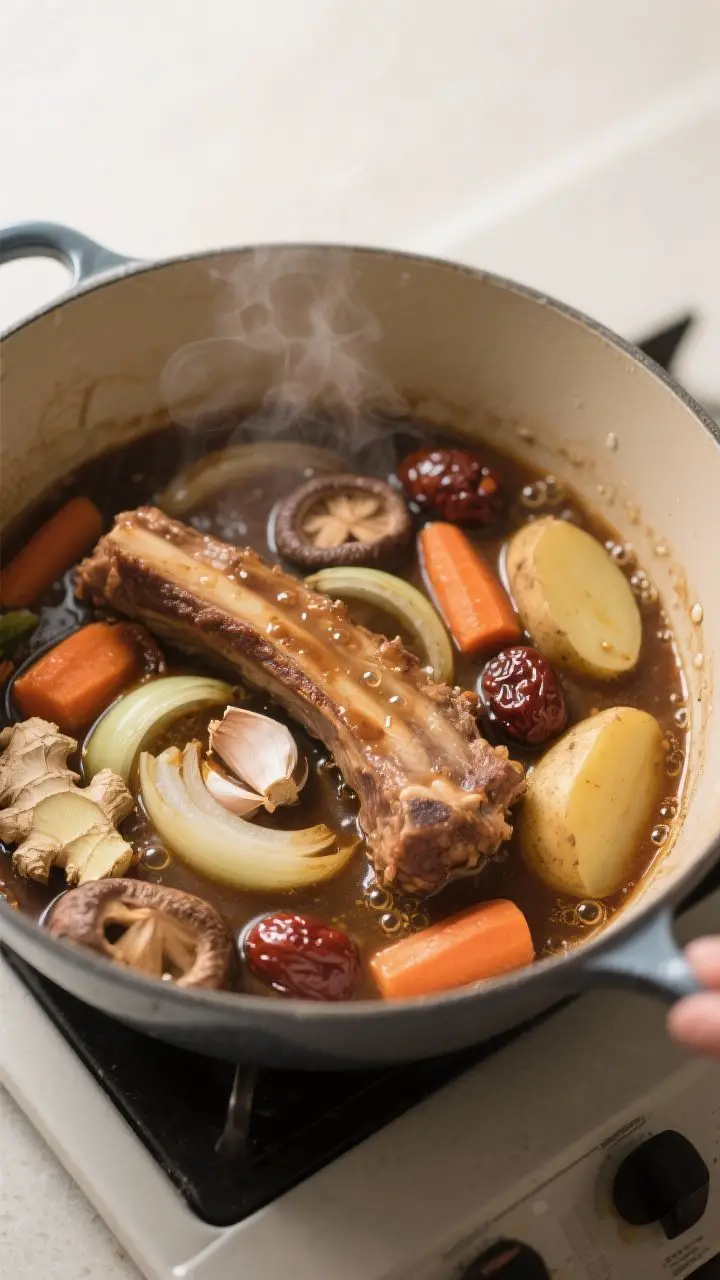
- Prep the ribs. Rinse the short ribs under cold water. Trim excess surface fat but leave some for flavor.
Soak in cold water for 20–30 minutes to draw out blood, changing the water once.
- Blanch. Place ribs in a large pot, cover with cold water, and bring to a boil. Simmer 5–8 minutes until foam rises. Drain and rinse the ribs and pot to remove scum.
- Make the braising sauce. In a bowl, whisk soy sauce, brown sugar, honey, mirin, water, grated pear, minced garlic, minced ginger, sesame oil, gochugaru, and black pepper.
- Start the braise. Return the blanched ribs to the clean pot.
Add onion, smashed garlic, sliced ginger, and the braising sauce. Add enough water to barely cover the ribs if needed.
- Simmer low and slow. Bring to a gentle simmer, cover, and cook over low heat for 60–75 minutes. Skim fat as it rises for a cleaner sauce.
- Add hearty vegetables. Stir in carrots, potatoes, daikon, mushrooms, and jujubes (if using).
Continue simmering uncovered 25–35 minutes, until the vegetables are tender and the sauce thickens.
- Reduce and finish. If the sauce is still thin, remove the lid and let it bubble for 5–10 more minutes to reduce to a glossy consistency. Add scallions in the last 2–3 minutes.
- Check seasoning. Taste and adjust. Add a splash of water if too salty, a pinch of sugar if too savory, or more black pepper for warmth.
- Serve. Sprinkle with sesame seeds.
Serve hot with steamed rice and, if you like, kimchi or simple greens.
Keeping It Fresh
- Fridge: Store in an airtight container for up to 4 days. The flavor improves on day two.
- Reheating: Warm gently on the stove over low heat with a splash of water to loosen the sauce. Microwaving works, but stir halfway for even heating.
- Freezer: Freeze in portions for up to 2 months.
Thaw overnight in the fridge and reheat slowly to keep the meat tender.
- Make-ahead tip: Cook a day ahead, chill, and lift off the solidified fat before reheating for a cleaner finish.

Benefits of This Recipe
- Deep flavor with simple steps: The technique is straightforward, yet the result tastes restaurant-worthy.
- Flexible and forgiving: Switch vegetables, adjust sweetness, or tweak heat without losing the essence.
- Great for gatherings: Scales well and holds beautifully on the stove or in a warm oven.
- Balanced nutrition: Protein-rich beef with fiber from vegetables; serve with rice and a simple cucumber salad for a complete meal.
- Leftovers shine: Flavors meld and intensify, making next-day meals even better.
Common Mistakes to Avoid
- Skipping the blanching step: This leads to cloudy broth and off flavors. It only takes a few minutes.
- Boiling too hard: Vigorous boiling toughens meat. Keep the simmer gentle and steady.
- Overcrowding with water: Too much liquid dilutes flavor.
Add just enough to partially cover, then reduce at the end.
- Adding vegetables too early: They’ll fall apart. Add once the meat is nearly tender.
- Underseasoning at the end: Taste and adjust. A small splash of soy or a pinch of sugar can balance everything.
Recipe Variations
- Sweet potato swap: Use sweet potatoes or kabocha squash instead of regular potatoes for a natural sweetness.
- Spicy kick: Add 1–2 tablespoons gochujang along with the sauce for a deeper, spicy-sweet profile.
- Pear-free version: Substitute with grated apple or 1 tablespoon sugar plus 1 teaspoon rice vinegar for balance.
- Pressure cooker/Instant Pot: Cook ribs and sauce at high pressure for 35–40 minutes, quick-release, then add vegetables and simmer on Sauté to reduce.
- Boneless short ribs or chuck: Works well if bone-in is unavailable.
Adjust time slightly; start checking tenderness earlier.
- Luxury touch: Add chestnuts during the vegetable stage for a classic holiday feel.
FAQ
Can I make Galbi Jjim without short ribs?
Yes. Chuck roast or beef shank will work, though the flavor is best with bone-in short ribs. Adjust the timing depending on thickness.
How do I know the meat is done?
It should be very tender when pierced with a fork and pull away from the bone easily.
If it’s still firm, keep simmering in 10–15 minute increments.
Is Galbi Jjim supposed to be sweet?
It’s gently sweet to balance the soy and aromatics. You can cut back on sugar and honey by a tablespoon or two if you prefer.
What can I use instead of mirin?
Use dry sherry, sake, or a mix of water with a teaspoon of sugar. Rice vinegar is not a good substitute here.
Can I thicken the sauce with cornstarch?
You can, but reducing the sauce naturally tastes better.
If you’re short on time, a small cornstarch slurry works in a pinch.
How spicy is this recipe?
By default, it’s mild. Gochugaru adds warmth, not extreme heat. For spicier results, add gochujang or a fresh chili.
What should I serve with it?
Steamed rice, kimchi, and a simple cucumber salad or blanched greens round out the meal nicely.
Can I prepare it ahead for guests?
Absolutely.
Make it a day ahead, chill, remove excess fat, and reheat gently. The flavor improves and hosting is easier.
Wrapping Up
Galbi jjim is all about slow, steady cooking and a beautifully balanced sauce. With a few smart moves—blanching, a gentle simmer, and a final reduction—you’ll get tender ribs and a glossy, savory-sweet finish.
It’s comforting, impressive, and endlessly adaptable. Make a big pot, share it with people you love, and enjoy the leftovers just as much the next day.

